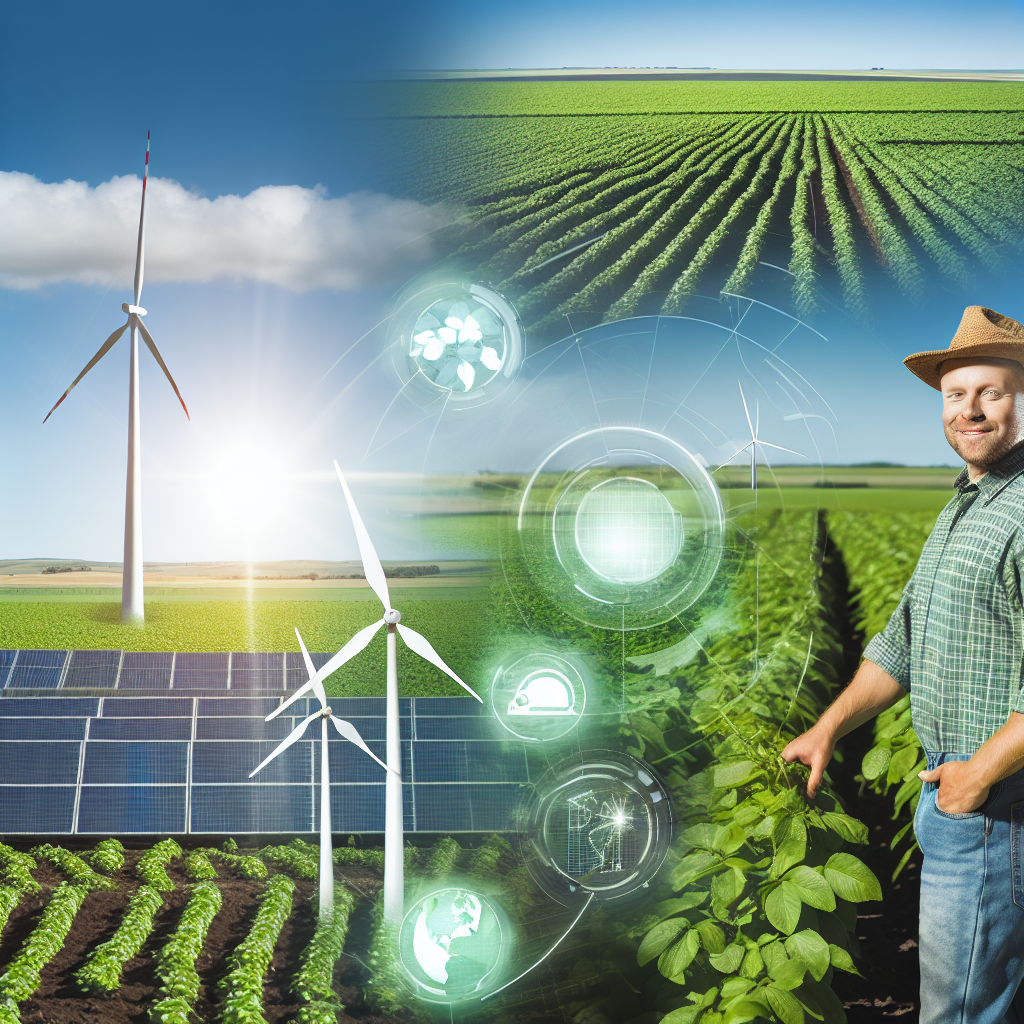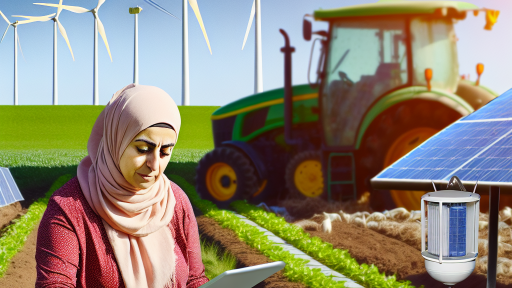Understanding the Types of Renewable Energy Available for Farms
Solar Energy
Solar energy harnesses sunlight to generate electricity.
Farmers can install solar panels on rooftops or open land.
This technology is becoming more affordable and efficient.
Moreover, solar farms can reduce energy costs significantly.
These systems can also provide tax credits and incentives.
Wind Energy
Wind energy uses turbines to convert wind into electricity.
Many farms benefit from the open spaces ideal for wind farms.
Installing turbines can generate significant energy over time.
In addition, farmers can sell excess energy back to the grid.
Government programs often support wind energy installations.
Biomass Energy
Biomass energy derives from organic materials like crop waste.
Farmers can utilize leftover plant materials for energy production.
This process helps reduce waste and provides an income stream.
Additionally, biomass can be converted into heat or electricity.
It may also qualify for various environmental credits.
Transform Your Agribusiness
Unlock your farm's potential with expert advice tailored to your needs. Get actionable steps that drive real results.
Get StartedGeothermal Energy
Geothermal energy harnesses heat from within the Earth.
This energy source is particularly effective for heating systems.
Farm operations can use it for heating greenhouses.
Furthermore, it can reduce reliance on fossil fuels.
Investing in geothermal systems often leads to energy savings.
Hydropower
Hydropower captures energy from flowing water sources.
Farmers near rivers or streams can consider small turbines.
This renewable source can provide a consistent energy supply.
Moreover, it can assist in irrigation systems on farms.
Recent advancements have made small-scale hydropower more feasible.
The Importance of Government Incentives in Renewable Energy Adoption
Encouraging Investment in Green Technology
Government incentives play a crucial role in boosting investment.
They lower the financial risks associated with renewable energy projects.
Moreover, these incentives can enhance profitability for farms adopting new technologies.
Incentives also encourage farmers to adopt innovative solutions for energy generation.
Enhancing Sustainability in Agriculture
Incentives promote sustainable practices within modern farming.
By adopting renewable energy, farmers can reduce their carbon footprint.
Additionally, sustainability leads to healthier ecosystems and improved soil quality.
This transition aligns farming practices with environmental responsibility.
Creating a Competitive Edge
Renewable energy incentives help farms remain competitive in the market.
By utilizing alternative energy sources, farmers lower their operational costs.
Consequently, they can offer competitive pricing on their products.
This advantage can attract more customers and expand market reach.
Boosting Economic Stability
Government incentives result in job creation within local communities.
As farms grow, they often require more personnel for operations.
Showcase Your Farming Business
Publish your professional farming services profile on our blog for a one-time fee of $200 and reach a dedicated audience of farmers and agribusiness owners.
Publish Your ProfileThis growth fosters local economies through increased spending.
Furthermore, sustainable energy projects can enhance energy security for farmers.
Facilitating Accessibility to Renewable Resources
Incentives make renewable energy technology more accessible for all farmers.
Financial assistance lowers the initial investment barriers.
Moreover, various programs provide resources and training for implementation.
This nurturing environment encourages widespread adoption across the farming sector.
Assessing Energy Needs and Consumption Patterns
Identifying Energy Sources on Your Farm
Your farm likely uses various energy sources.
These may include electricity, natural gas, propane, and diesel.
Begin by listing all energy sources in use.
Next, note how each source supports different farm operations.
Analyzing Energy Consumption Patterns
Gather data on your farm’s energy consumption.
Review utility bills for at least a year to find trends.
Identify peak usage periods, such as planting or harvesting seasons.
This analysis will reveal when your farm consumes the most energy.
Assessing Your Energy Efficiency
Examine the efficiency of your current energy systems.
Look for outdated appliances and equipment in your operations.
Consider conducting an energy audit to spot inefficiencies.
Upgrading to energy-efficient models can reduce costs significantly.
Understanding Renewable Energy Opportunities
Research available renewable energy options for your farm.
Solar panels, wind turbines, and biogas systems are common choices.
Determine how each option could fit your farm’s layout and needs.
Explore incentives available for implementing these technologies.
Consulting with Experts and Resources
Engage with renewable energy consultants for tailored advice.
Seek input from local agricultural extension services.
They can provide insights into best practices and funding opportunities.
Utilize online resources for additional information on renewable trends.
Developing an Action Plan
Create a strategic plan based on your assessments.
Your plan should include goals for energy reduction and renewable adoption.
Set realistic timelines and budget considerations for each stage.
Regularly review your progress and adjust the plan as needed.
Explore Further: Understanding Government Conservation Incentives For Farmers
Exploring Solar, Wind, and Biomass Energy Options for Farms
Understanding Solar Energy
Solar energy is a prime option for modern farms.
It harnesses sunlight through solar panels installed on-site.
This renewable source significantly reduces electricity costs.
Farmers can benefit from various incentives for solar installations.
Federal and state programs often provide financial support.
Moreover, solar investments increase property value.
Additionally, solar energy contributes to sustainability goals.
Advantages of Wind Energy
Wind energy offers another viable renewable option for farms.
Farmers can install wind turbines to generate electricity efficiently.
Showcase Your Farming Business
Publish your professional farming services profile on our blog for a one-time fee of $200 and reach a dedicated audience of farmers and agribusiness owners.
Publish Your ProfileThis method capitalizes on natural wind patterns in rural areas.
Wind energy systems often qualify for tax credits.
They can also produce income through energy sales to the grid.
Furthermore, wind installations have minimal environmental impact.
Utilizing Biomass Energy
Biomass energy transforms organic waste into usable fuel.
Farms produce ample biomass, including crop residues and animal waste.
This process reduces waste and provides renewable energy solutions.
Additionally, biomass systems can lower greenhouse gas emissions.
Farmers can access grants for establishing biomass facilities.
Notably, these systems boost energy independence for farms.
Integrating Multiple Renewable Sources
Integrating various renewable energy sources maximizes benefits.
For instance, combining solar and wind can enhance energy output.
This strategy optimizes resource use throughout different seasons.
Furthermore, mixed systems can lead to greater financial savings.
Farmers gain resilience against fluctuating energy prices.
Diversifying energy sources promotes sustainability and profit.
See Related Content: Climate-Smart Agriculture Conservation Initiatives
Step-by-Step Guide to Applying for Renewable Energy Grants and Tax Credits
Research Available Incentives
Start by exploring the types of renewable energy incentives available.
Government programs can offer significant support for farmers.
Consider both federal and state-level options for funding.
Many organizations provide resources that detail available grants.
Determine Eligibility Criteria
Each program may have specific eligibility requirements.
Carefully read the guidelines to understand what qualifies your farm.
Check if your renewable energy project aligns with funding goals.
This step prevents wasted time on applications that may not succeed.
Gather Required Documentation
Create a checklist of necessary documents for your application.
Typically, cover financial statements and project plans.
Include detailed descriptions of the planned renewable energy systems.
Ensure all documents are accurate and up-to-date.
Complete the Application Form
Access the application form from the specific funding program.
Fill out all sections thoroughly and accurately.
Pay careful attention to detail, avoiding common errors.
This increases your chances of approval significantly.
Submit Your Application
Submit your completed application following the specified format.
Double-check deadlines to ensure timely submission.
Consider submitting your application electronically when possible.
Save a copy of your application for your records.
Follow Up on Your Submission
After submission, stay proactive by following up with the funding agency.
Confirm they received your application and inquire about timelines.
This helps you stay informed about the review process.
Showcase Your Farming Business
Publish your professional farming services profile on our blog for a one-time fee of $200 and reach a dedicated audience of farmers and agribusiness owners.
Publish Your ProfilePrepare for Project Implementation
Once approved, begin planning for project execution.
Consult with renewable energy experts to ensure best practices.
Stay organized and keep track of all project activities.
This smooths the path for utilizing the granted funds effectively.
Discover More: How Farmers Can Access Government Grants for Agricultural R&D Projects

Integrating Renewable Energy Solutions into Daily Farming Operations
Benefits of Renewable Energy in Agriculture
Renewable energy offers various advantages for modern farms.
It can significantly lower energy costs over time.
Additionally, it contributes to sustainability efforts.
Farmers can enhance their energy independence through these solutions.
Moreover, using green energy may attract eco-conscious consumers.
Solar Energy for Farms
Solar panels provide an excellent opportunity for farmers.
They harness sunlight to generate electricity effectively.
This technology can power irrigation systems and barn lights.
Many farms can benefit from installing solar water heaters.
Additionally, local incentives may reduce the upfront costs.
Wind Energy Implementation
Wind turbines offer another renewable solution for landowners.
They produce energy through natural wind currents.
Farmers with large land areas can optimize turbine placements.
Furthermore, wind energy systems require minimal ongoing maintenance.
This contributes to a steady power supply for operations.
Biogas Generation from Farm Waste
Biogas systems convert organic waste into useful energy.
This includes manure and crop residues from farming activities.
Such systems not only provide energy but also manage waste efficiently.
As a result, farmers reduce their environmental footprint.
Incentives for biogas systems may be available through government programs.
Incorporating Energy Storage Solutions
Energy storage is vital for maximizing renewable resources.
Battery systems can store excess energy produced during peak hours.
This stored energy supports operations when production dips.
Farmers can avoid high costs during peak energy demand periods.
Furthermore, integrating smart technology enhances overall efficiency.
Financing Options for Renewable Energy Projects
Accessing funding for renewable energy is crucial for farmers.
Various grants and loans are available through government agencies.
Local banks and credit unions may offer tailored financing solutions.
Additionally, some companies provide leasing options for renewable systems.
Assessing and comparing these options will yield financial benefits.
Explore Further: Maximizing Agricultural Research and Development Funding: Tips for Farmers
Case Studies: Successful Implementation of Renewable Energy in Modern Farms
Solar Energy Adoption
Many farms now exploit solar energy for their operations.
For instance, Green Valley Farms installed solar panels on their barn roofs.
This decision significantly reduced their electricity costs.
Furthermore, they gained tax credits that boosted their savings.
Showcase Your Farming Business
Publish your professional farming services profile on our blog for a one-time fee of $200 and reach a dedicated audience of farmers and agribusiness owners.
Publish Your ProfileWind Energy Utilization
Wind energy is another effective renewable resource for farms.
Sunnydale Agriculture harnesses wind turbines to power their machinery.
This initiative not only cuts energy costs but also powers their irrigation systems.
Additionally, they sell unused energy back to the grid, generating extra income.
Biogas Production
Biogas systems create renewable energy from organic waste.
Prairie Organics uses this technology from livestock manure.
They turn waste into biogas, powering their heating systems.
This process reduces their carbon footprint and improves waste management.
Geothermal Energy Extraction
Geothermal energy offers a consistent energy source for modern farms.
For example, Riverbend Farm installed geothermal heating for their greenhouses.
This approach maintains optimal growing conditions throughout the year.
Moreover, it has decreased their reliance on fossil fuels dramatically.
Collaboration and Incentives
Working with local governments enhances renewable energy projects.
Farmers often participate in incentive programs to defray costs.
For instance, Cedarwood Farms received state grants for their solar installations.
These collaborations can enhance community relationships and promote sustainability.
Future Trends in Renewable Energy Technology and Agriculture Sustainability
Embracing Innovative Energy Solutions
Modern farms increasingly adopt innovative energy solutions for sustainability.
Solar panels have become a common sight across agricultural landscapes.
With advancements, farmers can efficiently harness solar energy.
Additionally, wind turbines offer another renewable energy option.
Implementing these technologies reduces energy costs significantly.
Consequently, farms can reinvest savings into enhancing productivity.
Integrating Renewable Energy with Farming Practices
Farmers are integrating renewable energy into daily practices effectively.
One approach involves using biogas systems for waste management.
These systems convert organic waste into usable energy.
Moreover, this process reduces greenhouse gas emissions remarkably.
Farmers also utilize energy-efficient equipment powered by renewables.
This equipment dramatically decreases fuel dependency.
The Role of Technology in Energy Management
Advancements in technology enhance energy management on farms.
Smart grids allow farmers to monitor and optimize energy usage.
Data analytics provide insights into energy consumption patterns.
As a result, farmers can make informed decisions for efficiency.
Additionally, automation controls can adjust energy loads dynamically.
This ultimately leads to a more sustainable farming operation.
Future Government Policies and Incentives
Government policies increasingly support renewable energy adoption.
Incentives such as tax credits encourage energy-efficient investments.
Grants and low-interest loans further facilitate this transition.
Additionally, agencies provide valuable resources and training.
Farmers must stay informed about these evolving opportunities.
Therefore, engaging with local government can maximize benefits.
Showcase Your Farming Business
Publish your professional farming services profile on our blog for a one-time fee of $200 and reach a dedicated audience of farmers and agribusiness owners.
Publish Your ProfileCollaboration and Community Engagement
Collaboration among farmers enhances renewable energy initiatives.
Community solar projects allow shared benefits for multiple farms.
Partnerships foster knowledge sharing and resource optimization.
Moreover, networking can lead to collective purchasing power.
This reduces costs for renewable energy technologies.
Ultimately, community efforts strengthen sustainability goals.




